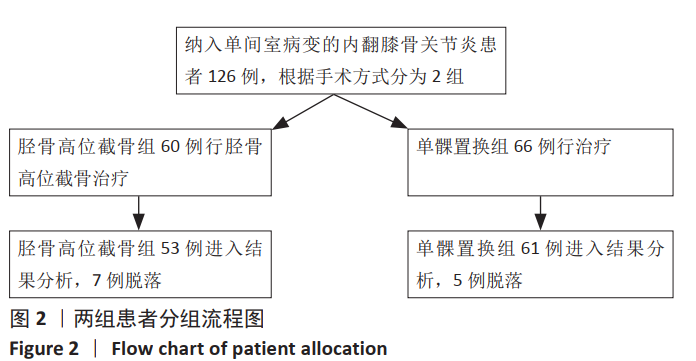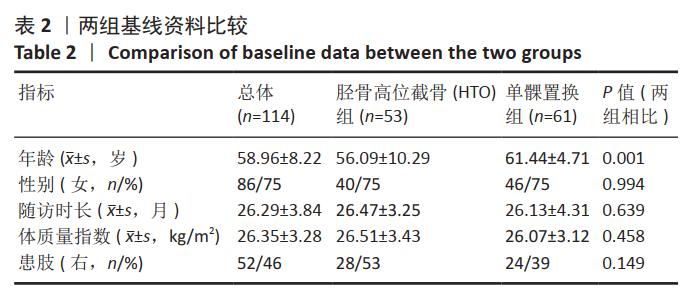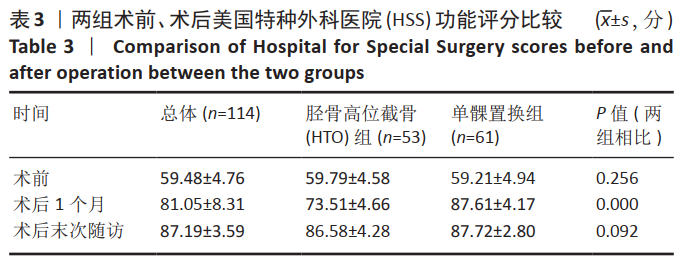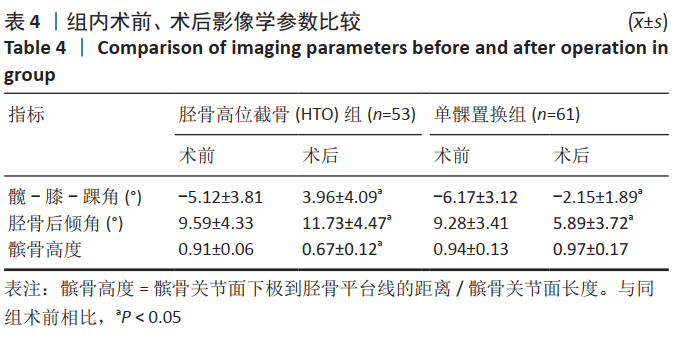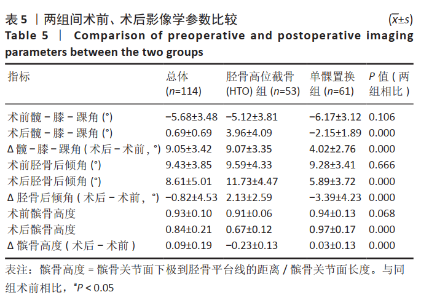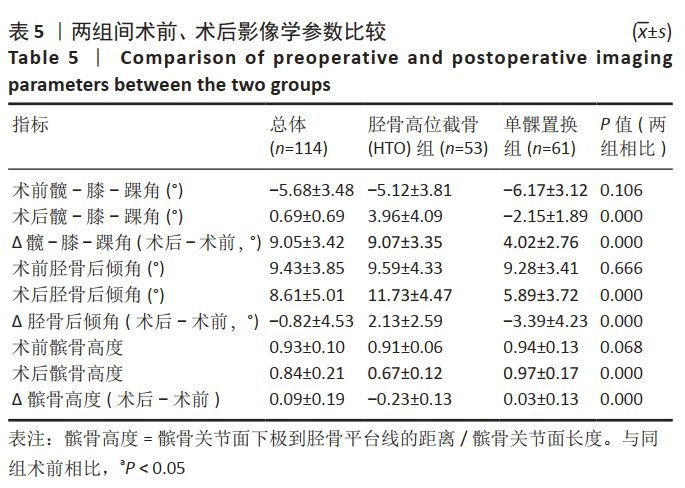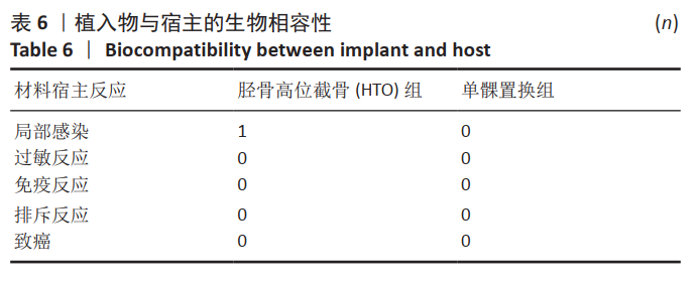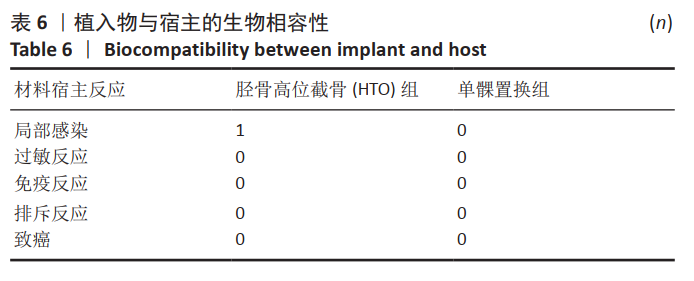Chinese Journal of Tissue Engineering Research ›› 2021, Vol. 25 ›› Issue (30): 4793-4798.doi: 10.12307/2021.263
Previous Articles Next Articles
Unicompartmental knee arthroplasty superior to open-wedge high tibial osteotomy: differences of mechanical parameters and knee function
Lin Xiaodong, Liu Wengang, Xu Xuemeng, Liu Xin, Lu Chao, Song Min, Li Congcong
- Guangdong Second Hospital of Traditional Chinese Medicine, Guangzhou University of Chinese Medicine, Guangzhou 510095, Guangdong Province, China;
-
Received:2020-11-19Revised:2020-11-21Accepted:2021-01-07Online:2021-10-28Published:2021-07-29 -
Contact:Liu Wengang, MD, Chief physician, Guangdong Second Hospital of Traditional Chinese Medicine, Guangzhou University of Chinese Medicine, Guangzhou 510095, Guangdong Province, China -
About author:Lin Xiaodong, Master, Physician, Guangdong Second Hospital of Traditional Chinese Medicine, Guangzhou University of Chinese Medicine, Guangzhou 510095, Guangdong Province, China -
Supported by:the Scientific Research Project of Guangdong Bureau of Traditional Chinese Medicine, No. 20183001 (to LWG), No. 20191021 (to LC); the Science and Technology Project of Guangzhou, No. 202002030204 (to LWG)
CLC Number:
Cite this article
Lin Xiaodong, Liu Wengang, Xu Xuemeng, Liu Xin, Lu Chao, Song Min, Li Congcong. Unicompartmental knee arthroplasty superior to open-wedge high tibial osteotomy: differences of mechanical parameters and knee function[J]. Chinese Journal of Tissue Engineering Research, 2021, 25(30): 4793-4798.
share this article
Add to citation manager EndNote|Reference Manager|ProCite|BibTeX|RefWorks
| [1] PAREDES-CARNERO X, LEYES M, FORRIOL F, et al. Long-term results of total knee arthroplasty after failed high tibial osteotomy. Int Orthop. 2018;42(9):2087-2096. [2] LEE YS, KIM HJ, MOK SJ, et al. Similar Outcome, but Different Surgical Requirement in Conversion Total Knee Arthroplasty following High Tibial Osteotomy and Unicompartmental Knee Arthroplasty: A Meta-Analysis. J Knee Surg. 2019;32(7):686-700. [3] HERRY Y, BATAILLER C, LORDING T, et al. Improved joint-line restitution in unicompartmental knee arthroplasty using a robotic-assisted surgical technique. Int Orthop. 2017;41(11):2265-2271. [4] BODE G, VON HEYDEN J, PESTKA J, et al. Prospective 5-year survival rate data following open-wedge valgus high tibial osteotomy.Knee Surg Sports Traumatol Arthrosc. 2015;23(7):1949-1955. [5] KIM MS, KOH IJ, SOHN S, et al. Unicompartmental knee arthroplasty is superior to high tibial osteotomy in post-operative recovery and participation in recreational and sports activities. Int Orthop. 2019; 43(11):2493-2501. [6] FU D, LI G, CHEN K, et al. Comparison of high tibial osteotomy and unicompartmental knee arthroplasty in the treatment of unicompartmental osteoarthritis: a meta-analysisp.J Arthroplasty. 2013;28(5):759-765. [7] 王长海,王永成,李华. 胫骨高位截骨术与单髁置换术的早期疗效及费用比较[J]. 中华关节外科杂志(电子版),2020,14(3):314-319. [8] 丁勇, 李钊, 胡运生,等. 单髁置换术与胫骨高位截骨术治疗膝骨性关节炎疗效比较[J]. 生物骨科材料与临床研究,2015,12(2):75-77. [9] DETTONI F, BONASIA DE, CASTOLDI F, et al. High tibial osteotomy versus unicompartmental knee arthroplasty for medial compartment arthrosis of the knee: a review of the literature. Iowa Orthop J. 2010;30:131-140. [10] ROSSI R, BONASIA DE, AMENDOLA A. The role of high tibial osteotomy in the varus knee.J Am Acad Orthop Surg. 2011;19(10):590-599. [11] STAUBLI AE, JACOB HA. Evolution of open-wedge high-tibial osteotomy: experience with a special angular stable device for internal fixation without interposition material. Int Orthop. 2010;34(2):167-172. [12] KOH IJ, KIM JH, JANG SW, et al. Are the Oxford(®) medial unicompartmental knee arthroplasty new instruments reducing the bearing dislocation risk while improving components relationships? A case control study. Orthop Traumatol Surg Res. 2016;102(2):183-187. [13] CHO WJ, KIM JM, KIM WK, et al. Mobile-bearing unicompartmental knee arthroplasty in old-aged patients demonstrates superior short-term clinical outcomes to open-wedge high tibial osteotomy in middle-aged patients with advanced isolated medial osteoarthritis.Int Orthop. 2018;42(10):2357-2363. [14] IVARSSON I, GILLQUIST J. Rehabilitation after high tibial osteotomy and unicompartmental arthroplasty. A comparative study. Clin Orthop Relat Res. 1991;(266):139-144. [15] JACQUET C, GULAGACI F, SCHMIDT A, et al. Opening wedge high tibial osteotomy allows better outcomes than unicompartmental knee arthroplasty in patients expecting to return to impact sports. Knee Surg Sports Traumatol Arthrosc. 2020;2(1):1007-1016. [16] EL-AZAB H, GLABGLY P, PAUL J, et al. Patellar height and posterior tibial slope after open- and closed-wedge high tibial osteotomy: a radiological study on 100 patients. Am J Sports Med. 2010;38(2):323-329. [17] HINTERWIMMER S, BEITZEL K, PAUL J, et al. Control of posterior tibial slope and patellar height in open-wedge valgus high tibial osteotomy. Am J Sports Med. 2011;39(4):851-856. [18] STOFFEL K, WILLERS C, KORSHID O, et al. Patellofemoral contact pressure following high tibial osteotomy: a cadaveric study.Knee Surg Sports Traumatol Arthrosc. 2007;15(9):1094-1100. [19] JAVIDAN P, ADAMSON GJ, MILLER JR, et al. The effect of medial opening wedge proximal tibial osteotomy on patellofemoral contact. Am J Sports Med. 2013;41(1):80-86. [20] Kim KI, Kim DK, Song SJ, et al. Medial Open-Wedge High Tibial Osteotomy May Adversely Affect the Patellofemoral Joint. Arthroscopy. 2017;33(4):811-816. [21] GOSHIMA K, SAWAGUCHI T, SHIGEMOTO K, et al. Patellofemoral Osteoarthritis Progression and Alignment Changes after Open-Wedge High Tibial Osteotomy Do Not Affect Clinical Outcomes at Mid-term Follow-up. Arthroscopy. 2017;33(4):1832-1839. [22] OGAWA H, MATSUMOTO K, YOSHIOKA H, et al. Distal tibial tubercle osteotomy is superior to the proximal one for progression of patellofemoral osteoarthritis in medial opening wedge high tibial osteotomy. Knee Surg Sports Traumatol Arthrosc. 2020;28(10):3270-3278. [23] LEE YS, LEE SB, OH WS, et al. Changes in Patellofemoral alignment do not cause clinical impact after open-wedge high tibial osteotomy. Knee Surg Sports Traumatol Arthrosc. 2016;24(1):129-133. [24] LEE SS, SO SY, JUNG EY. Predictive factors for patellofemoral degenerative progression after opening-wedge high tibial osteotomy. Arthroscopy. 2019;35(6):1703-1710. [25] 林晓东,郑沐欣,夏威夷,等. 胫骨后倾角在膝关节手术中的临床意义[J]. 中华创伤骨科杂志,2019,21(10):914-917. [26] NHA KW, KIM HJ, AHN HS, et al. Change in Posterior Tibial Slope After Open-Wedge and Closed-Wedge High Tibial Osteotomy: A Meta-analysis. Am J Sports Med. 2016;44(11):3006-3013. [27] TÜRKMEN F, KAÇIRA BK, ÖZKAYA M, et al. Comparison of monoplanar versus biplanar medial opening-wedge high tibial osteotomy techniques for preventing lateral cortex fracture. Knee Surg Sports Traumatol Arthrosc. 2017;25(9):2914-2920. [28] LEE SS, NHA KW, LEE DH. Posterior cortical breakage leads to posterior tibial slope change in lateral hinge fracture following opening wedge high tibial osteotomy. Knee Surg Sports Traumatol Arthrosc. 2019; 27(3):698-706. [29] JO HS, PARK JS, BYUN JH, et al. The effects of different hinge positions on posterior tibial slope in medial open-wedge high tibial osteotomy. Knee Surg Sports Traumatol Arthrosc. 2018;26(6):1851-1858. [30] OGAWA H, MATSUMOTO K, OGAWA T, et al. Effect of Wedge Insertion Angle on Posterior Tibial Slope in Medial Opening Wedge High Tibial Osteotomy.Orthop J Sports Med. 2016;4(2):2325967116630748. [31] KIM GB, KIM KI, SONG SJ, et al. Increased Posterior Tibial Slope After Medial Open-Wedge High Tibial Osteotomy May Result in Degenerative Changes in Anterior Cruciate Ligament. J Arthroplasty. 2019;34(9):1922-1928. [32] EVANS JT, WALKER RW, EVANS JP, et al. How long does a knee replacement last? A systematic review and meta-analysis of case series and national registry reports with more than 15 years of follow-up. Lancet. 2019;393(10172):655-663. [33] EL-GALALY A, NIELSEN PT, KAPPEL A, et al. Reduced survival of total knee arthroplasty after previous unicompartmental knee arthroplasty compared with previous high tibial osteotomy: a propensity-score weighted mid-term cohort study based on 2,133 observations from the Danish Knee Arthroplasty Registry. Acta Orthop. 2020;91(2):177-183. [34] LIM JBT, CHONG HC, PANG HN, et al. Revision total knee arthroplasty for failed high tibial osteotomy and unicompartmental knee arthroplasty have similar patient-reported outcome measures in a two-year follow-up study. Bone Joint J. 2017;99-B(10):1329-1334. [35] LUNEBOURG A, PARRATTE S, OLLIVIER M, et al. Are Revisions of Unicompartmental Knee Arthroplasties More Like a Primary or Revision TKA? J Arthroplasty. 2015;30(11):1985-1989. [36] 王欢,孙贺,张耀南,等.中国40岁以上人群原发性膝骨关节炎各间室患病状况调查[J].中华骨与关节外科杂志,2019,12(7):528-532. |
| [1] | Li Yongjie, Fu Shenyu, Xia Yuan, Zhang Dakuan, Liu Hongju. Correlation of knee extensor muscle strength and spatiotemporal gait parameters with peak knee flexion/adduction moment in female patients with knee osteoarthritis [J]. Chinese Journal of Tissue Engineering Research, 2024, 28(9): 1354-1358. |
| [2] | Du Changling, Shi Hui, Zhang Shoutao, Meng Tao, Liu Dong, Li Jian, Cao Heng, Xu Chuang. Efficacy and safety of different applications of tranexamic acid in high tibial osteotomy [J]. Chinese Journal of Tissue Engineering Research, 2024, 28(9): 1409-1413. |
| [3] | Huang Xiarong, Hu Lizhi, Sun Guanghua, Peng Xinke, Liao Ying, Liao Yuan, Liu Jing, Yin Linwei, Zhong Peirui, Peng Ting, Zhou Jun, Qu Mengjian. Effect of electroacupuncture on the expression of P53 and P21 in articular cartilage and subchondral bone of aged rats with knee osteoarthritis [J]. Chinese Journal of Tissue Engineering Research, 2024, 28(8): 1174-1179. |
| [4] | Zhang Zeyi, Yang Yimin, Li Wenyan, Zhang Meizhen. Effect of foot progression angle on lower extremity kinetics of knee osteoarthritis patients of different ages: a systematic review and meta-analysis [J]. Chinese Journal of Tissue Engineering Research, 2024, 28(6): 968-975. |
| [5] | Shen Feiyan, Yao Jixiang, Su Shanshan, Zhao Zhongmin, Tang Weidong. Knockdown of circRNA WD repeat containing protein 1 inhibits proliferation and induces apoptosis of chondrocytes in knee osteoarthritis [J]. Chinese Journal of Tissue Engineering Research, 2024, 28(4): 499-504. |
| [6] | Li Chun, Zhang Yanlin, Liu Di, Wang Minglei, Wang Duo, Liu Junwei, Wu Yongli. Effect of warm-needling moxibustion on anterior cruciate ligament injury repair and related growth factors in rabbits with knee osteoarthritis [J]. Chinese Journal of Tissue Engineering Research, 2024, 28(23): 3621-3626. |
| [7] | Zhu Shijie, Yang Yiting, Cao Yuting, Zheng Liangdong, Lin Kaili, Zhu Rui. Cartilage protective effect of swimming exercise in aged mice with knee osteoarthritis [J]. Chinese Journal of Tissue Engineering Research, 2024, 28(20): 3170-3175. |
| [8] | Wang Ke, Zhang Zeyi, Zhang Liwen, Zhang Meizhen. Biomechanics characteristics during sitting up in knee osteoarthritis patients of different ages: a systematic review and meta-analysis [J]. Chinese Journal of Tissue Engineering Research, 2024, 28(18): 2939-2946. |
| [9] | Gu Xu, Zheng Xin, Shi Sifeng, Lu Renxiang, Cao Jie, Li Hongwei. Stability of early gait after unicompartmental knee arthroplasty [J]. Chinese Journal of Tissue Engineering Research, 2024, 28(12): 1875-1879. |
| [10] | Zhang Huizhen, Wu Wei, Luo Haitao. Medium to low intensity exercise interferes with the expression of LncRNA HOTAIR in chondrocytes in high-fat-fed mice with knee joint damage [J]. Chinese Journal of Tissue Engineering Research, 2024, 28(11): 1684-1689. |
| [11] | Zeng Jiaxu, He Qi, Chen Bohao, Li Miao, Li Shaocong, Yang Junzheng, Pan Zhaofeng, Wang Haibin. An insight into the mechanism of iron overload in knee osteoarthritis under the theory of blood stasis [J]. Chinese Journal of Tissue Engineering Research, 2024, 28(11): 1743-1748. |
| [12] | Mo Jian, Ye Sentao, Zhang Xiaoyun. Progress in the treatment of knee osteoarthritis with monomer and compound Chinese medicine [J]. Chinese Journal of Tissue Engineering Research, 2024, 28(11): 1756-1761. |
| [13] | Yan Wei, Kong Bo, Xi Xiaobing, Xu Yong, Jia Youji, Ruan Beite, Zhang Jiahui, Ma Honghong, Li Zhongwei. Compound cottonrose hibiscus leaf gel plaster of optimal “Xiaozhongsan” formulation for knee synovitis [J]. Chinese Journal of Tissue Engineering Research, 2024, 28(10): 1580-1585. |
| [14] | Shen Feiyan, Yao Jixiang, Su Shanshan, Zhao Zhongmin, Tang Weidong. Knockdown of circRNA WD repeat containing protein 1 inhibits proliferation and induces apoptosis of chondrocytes in knee osteoarthritis [J]. Chinese Journal of Tissue Engineering Research, 2023, 27(在线): 1-6. |
| [15] | Li Xiaomin, Tian Xiangdong, Tan Yetong, Zhu Guangyu, Wang Rongtian, Wang Jian, Xue Zhipeng, Ma Sheng, Hu Yuanyi, Huang Ye, Ding Tiansong. Changes of lower limb force line and knee function after high tibial osteotomy in osteoporotic medial ventricular knee osteoarthritis [J]. Chinese Journal of Tissue Engineering Research, 2023, 27(9): 1325-1329. |
| Viewed | ||||||
|
Full text |
|
|||||
|
Abstract |
|
|||||

